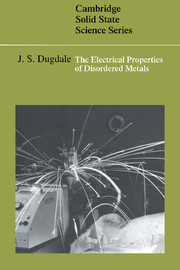Book contents
- Frontmatter
- Contents
- Preface
- 1 Context and content
- 2 Production and structure of metallic glasses
- 3 Electron transport in metals: introduction to conventional theory
- 4 Scattering
- 5 Simple liquid metals: Ziman theory
- 6 Phonons in disordered systems
- 7 Interactions and quasi-particles
- 8 Transition metals and alloys
- 9 The Hall coefficient of metallic glasses
- 10 Magnetoresistance
- 11 Electrical conductivity of metallic glasses: weak localisation
- 12 The interaction effect or Coulomb anomaly
- 13 The effect of the Coulomb interaction on conductivity
- 14 Influence of a magnetic field on the enhanced interaction effect
- 15 The thermopower of metals and alloys
- 16 Comparison with experiment
- Appendices
- Notes
- References
- Index
11 - Electrical conductivity of metallic glasses: weak localisation
Published online by Cambridge University Press: 21 January 2010
- Frontmatter
- Contents
- Preface
- 1 Context and content
- 2 Production and structure of metallic glasses
- 3 Electron transport in metals: introduction to conventional theory
- 4 Scattering
- 5 Simple liquid metals: Ziman theory
- 6 Phonons in disordered systems
- 7 Interactions and quasi-particles
- 8 Transition metals and alloys
- 9 The Hall coefficient of metallic glasses
- 10 Magnetoresistance
- 11 Electrical conductivity of metallic glasses: weak localisation
- 12 The interaction effect or Coulomb anomaly
- 13 The effect of the Coulomb interaction on conductivity
- 14 Influence of a magnetic field on the enhanced interaction effect
- 15 The thermopower of metals and alloys
- 16 Comparison with experiment
- Appendices
- Notes
- References
- Index
Summary
Having looked at some of the ideas in terms of which the electrical conductivity of metals has conventionally been interpreted, we now look at the conductivity of metallic glasses to see how far we can understand it in terms of what we have learned. The broad features of the conductivity of glasses made from simple metals have been interpreted in terms of the Ziman model (as established for simple metal liquids). Those that contain a substantial proportion of at least one transition metal have properties that cannot, for the most part, be so interpreted and indeed it was soon recognised that even simple metal alloys require an extension of the theory. Because all these materials we are considering are highly disordered, we can be sure that their electrical resistivity will be large at all temperatures and will not vary a great deal with temperature; its precise magnitude will of course depend on the specific constituents of the alloy.
There is one generalisation that can be made at the outset. Experimental data show that, as we would expect, the residual resistivity, ρo? of a glass is comparable to that of the corresponding liquid and indeed its resistance looks like the natural continuation of that of the liquid to low temperatures. This is illustrated in Figure 11.1 for Ni60Nb40 and Pd81S19, which also shows that the crystalline form at low temperatures with its much higher degree of order has a much lower resistivity. All this is reassuring.
- Type
- Chapter
- Information
- The Electrical Properties of Disordered Metals , pp. 105 - 139Publisher: Cambridge University PressPrint publication year: 1995

